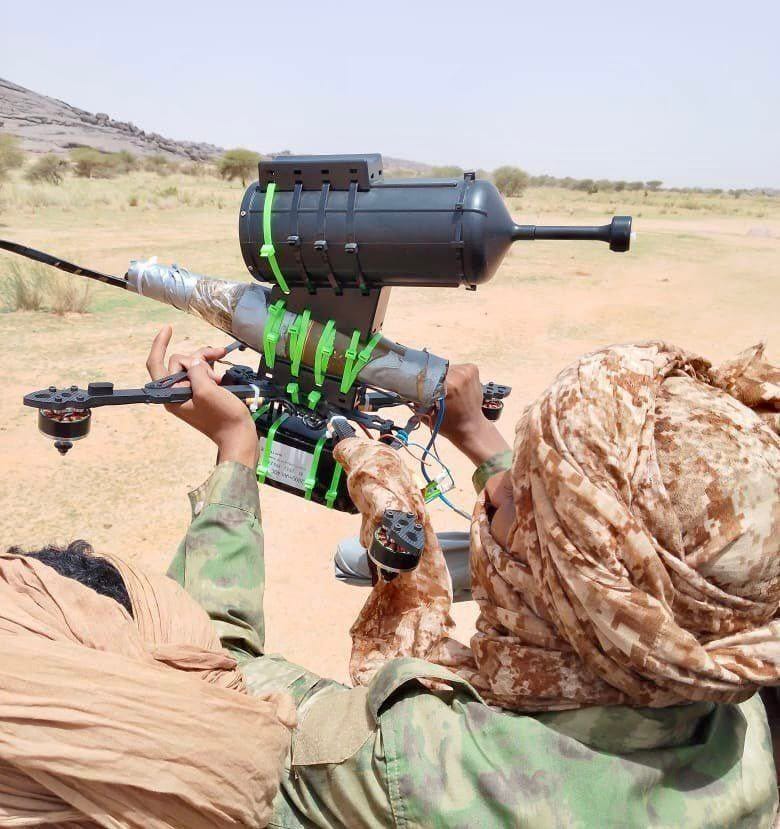Fiber Optic "FPV" Multirotor Drone Appears In Hands of FLA In Mali, Highlights Scope For Diffusion Worldwide
🇲🇱 🇷🇺 🇺🇦
A new image circulating on social media shows an armed so-called “first person video” (“FPV”) multirotor drone in the hands of the Azawad Liberation Front (Front de liberation de l'Azawad, or FLA) in northern Mali. While the FLA’s use of armed FPV drones has been public knowledge for some time, the new image indicates that the FLA now has in its possession armed “FPV” multirotor drones of the fiber optic (FO) communications uplink/downlink variety. While FO munitions, namely missiles, have existed for several decades, FO multirotor drones only rose to prominence in 2024 in the specific context of the Russia-Ukraine War as a response to the increasingly widespread deployment of electronic warfare (EW) systems to protect vehicles and other potential targets against armed “FPV” multirotor drones that were reliant on a radio frequency (RF) uplink/downlink. The appearance of an FO armed “FPV” multirotor drone in Mali amounts to a major development and likely heralds the forthcoming diffusion of such systems worldwide.
The FLA is one of the belligerents involved in the complex ongoing conflict in Mali, a conflict that has not only drawn in military intervention on the part of African countries but also Russia and, reports and developments—including the presence of a FO “FPV” multirotor drone—suggest, Ukraine. Russian support for the government in Bamako, which was first manifested in terms of the deployment of the forces of the Wagner private military company and is now manifested in terms of the deployment of forces that are part of the Russian Ministry of Defence-affiliated Africa Corps, appears to have catalyzed Ukrainian support for the FLA. While Ukraine could have waged a proxy war against Russian forces deployed in Mali by supporting the FLA in any number of ways, decision-makers in Kyiv appear to have made the fateful decision to transfer armed commercial-off-the-shelf (COTS) “FPV” multirotor drones to the FLA, thereby making the war in Mali one of the earliest cases of the diffusion of a genus of armed uncrewed aircraft that largely came into being in the context of the Russia-Ukraine War.
The full scope of Ukrainian support to the FLA in the area of armed “FPV” multirotor drones is not public knowledge. Observers working with access to open source information must rely on the FLA’s press releases and the videos that it selectively discloses, as well as disclosures made by Russian forces in Mali and disclosures made on Russian language social media more generally. The FLA has released several videos in recent months that offered clear-cut evidence of its employment of armed "FPV” multirotor drones of the RF uplink/downlink variety, which continue to be employed on an extraordinarily large scale everyday in the Russia-Ukraine War—neither the Russian nor the Ukrainian War efforts will be harmed by the transfer of even several hundred such COTS uncrewed aircraft-turned-munitions to Mali.
The above video was released in May 2025 and shows (A) an attack on a parked truck and (B) a seemingly unsuccessful attack on a nearby structure. It is important to note the loss of the RF communication uplink/downlink as the armed “FPV” multirotor drones dived toward their intended targets. All relevant terrestrial RF communications links are line-of-sight (LOS) systems. As an armed RF “FPV” multirotor drone descends in altitude, it tends to experience the loss of LOS to the ground station antenna and/or the airborne repeater, which is to say another multirotor drone that serves as an airborne radio relay. Note the loss of the LOS RF uplink/downlink at an altitude of approximately 5 meters in the above video. It is worth noting that there is no indication of the FLA employing other multirotor drones as airborne repeaters/airborne radio relays at this time.
While armed “FPV” multirotor drones of the FO variety are inherently very resilient to the effects of EW, the use of an FO uplink/downlink offers other very important benefits. Such multirotor drones are equipped with a spool of FO cable that is laid onto the ground as the drone moves in flight. FO “FPV” multirotor drones are, in effect, wire-guided drones analogous to both anti-tank missiles equipped with copper wire cables, which are LOS munitions, and anti-tank missiles equipped with FO cables, which can be used as either LOS or non-LOS (NLOS) munitions. It is important to note that the FO cable simply descends to the ground and that no tension is applied to the FO cable as would be the case if the FO cable spool remained stationary at the launch site.
The FLA also released two videos showing its use of armed “FPV” multirotor drones of the RF uplink/downlink variety in June 2025.
This first video from June 2025 captures an attack on an excavator loaded onto a flatbed as well as an attack on what is likely to be a truck carrying a water tank. Logistics vehicles, including construction plant and tanker trucks carrying fuel and water, tend to be wholly unarmoured. The pairing of armed “FPV” multirotor drones and off-the-shelf warheads such as the PG-7—used with the widely available RPG-7 rocket launcher—transforms the rather humble PG-7, which is highly effective against lightly armoured and unarmoured vehicles even as it is increasingly inadequate against the frontal armour of the latest armoured vehicle designs, into a devastatingly effective low-cost munition.
It is important to recognize that the COTS “FPV” multirotor drone, which can be acquired in large quantities at a unit cost of just several hundred dollars—excluding the warhead, is not itself capable of inflicting major damage onto an unarmoured let alone an armoured vehicle. The combination, however, transforms the otherwise rather humble PG-7 warhead into what is best characterized and understood as the all-aspect shaped charge threat, a threat that is lethal to even the most advanced armoured vehicles by virtue of allowing the remote human operator to undertake NLOS attacks against the roof, rear, and side areas of an armoured vehicle, which are generally far less well protected than the frontal arc that has to date been the primary focus on armoured vehicle designers concerned about vehicular weight, cost, and a variety of logistical considerations. This is all to say that the all-aspect shaped charge warhead threat enabled by the pairing of widely available and inexpensive PG-7 shaped charge warheads with widely available and inexpensive COTS “FPV” multirotor drones poses a threat to the vehicular convoys of all militaries. The above video may as well have shown Malian and/or Russian armoured personnel carriers being targeted instead of an excavator and a water truck.
The above video was also released in June 2025. This video highlights one of the limitations of low-cost “FPV” multirotor drones: the combination of an inexpensive low-definition electro-optical sensor and a low-cost analogue RF transmitter results in a sensor feed that can only be characterized as terrible even when flying at an altitude of around 180 meters in broad daylight with the aim of spotting potential targets in the Sahara. The situation with armed “FPV” multirotor drones of the FO variety—which have trade-offs and come with their own limitations—is very different, and the FLA will benefit from a major increase in its combat capabilities if and when these are regularly deployed in meaningful numbers, which in the context of this war can be as low as several dozen units per month. Conflicts in places like sub-Saharan Africa are not like the Russia-Ukraine War: there is not an “endless” supply of military vehicles and other forms of equipment available. Lost equipment either cannot be replaced or will take weeks, if not months, to replace unless a patron state is willing and able to fly in replacements at scale and at great expense.
Two of my recent posts on the use of armed “FPV” multirotor drones, including those of the FO variety, against fixed infrastructure sites in the Russia-Ukraine War help illustrate the potentially transformative effects such COTS uncrewed aircraft turned munitions are likely to have on the war in Mali and other conflicts going forward:
Russian "FPV" Multirotor Drone Strikes Against Kherson Thermal Power Plant Highlight Scope For The Surgical Targeting of Fixed Infrastructure Sites
Viewing so-called “First Person Video” (“FPV”) drone footage from the Russia-Ukraine War is often a quite sordid affair. There are, however, several “genres” of “FPV” drone footage that are not only more palatable to non-sadistic audiences by virtue of not (directly) injuring or killing any human beings but by offering a window into the new options—and …
"FPV" Drone Strikes Against Petrol/Gas Stations In Russia And Ukraine Highlights Increasing Scope For The Surgical Targeting of Fixed Infrastructure Sites
Note: This post expands on the theme of one of my previous posts. This is an issue area that I take great interest in, and the videos featured in this post are likely to be a harbinger of what is to come in terms of short-range strike capabilities worldwide. Expect additional posts dealing with this theme.




